Beef is divided into eight primal cuts: chuck, rib, loin, round, flank, plate, brisket, and shank. Each cut offers unique flavors and textures based on its location and muscle activity. Understanding these cuts helps you select the right cooking method—from slow-cooking tough cuts like brisket to quickly grilling tender cuts like ribeye.
| Primal Cut | Location | Characteristics | Best Cooking Methods |
|---|---|---|---|
| Chuck | Shoulder/neck | Flavorful, tough | Braising, stewing, slow cooking |
| Rib | Upper center back | Tender, marbled | Grilling, roasting |
| Loin | Lower back | Very tender, premium | Grilling, pan-searing |
| Round | Rear leg | Lean, tougher | Roasting, braising |
| Brisket | Chest/breast | Tough, flavorful | Smoking, braising, slow cooking |
Getting Started
Why It’s Important to Know About Beef Primal Cuts
If you love cooking or eating beef then knowing about primal cuts is super important. It not only helps you get better at cooking but also makes grocery shopping easier. Once you get to know the different primal cuts you could:
- Improve Your Cooking Skills: Each cut has its own best ways to cook that bring out its texture and flavor.
- Save Money: Being aware of which primal cuts are budget-friendly means you can keep delicious meals on the table without overspending.
- Enjoy Unique Flavors: Different cuts can add exciting flavors to your dishes giving you lots of creative cooking options.
A Quick Look Back at Beef Primal Cuts
When you think about beef primal cuts there’s a long history behind them connected to butchery and cooking. These primal cuts were once essential for everyday meals with every part of meat being used based on its characteristics.
- The eight main primal cuts – chuck rib loin round flank plate shank and brisket – come from traditional butchering practices.
- Over time folks have grown to really appreciate certain cuts and many cooking methods have popped up around them.
By grasping how each primal cut came about you’ll get a whole new appreciation for the meat on your plate.
Beef Anatomy and Primal Cuts Overview
Getting to Know Beef Anatomy
If you want to appreciate the variety of beef cuts it’s important to understand the anatomy of a cow. Cows are split into different sections each one contributing to different primal cuts. Here’s a quick breakdown:
- Forequarter: This is the front half of the cow where the muscles get a lot of work from movement.
- Hindquarter: This is the back half where you find more tender cuts since these muscles aren’t used as much.
It’s cool to see how the cow’s muscle activity over its lifetime affects the flavor and tenderness of the meat. Muscles that get a workout tend to yield tougher cuts.
A Closer Look at Primal Cuts and Where They Are
Beef breaks down into eight main primal cuts:
- Chuck: Found around the shoulder and neck this cut is flavorful but can be tougher.
- Rib: Comes from the rib section with marbling that makes it tender.
- Loin: Found behind the ribs this cut is home to some of the most tender steaks like T-bone and tenderloin.
- Round: Comes from the back leg this cut is leaner and can be tougher.
- Flank: Located below the loin it’s flavorful and benefits from marinating.
- Plate: Near the stomach this cut is known for its rich flavor and fat.
- Brisket: From the breast area it requires slow cooking to become tender.
- Shank: Found in the legs this one is tough but packed with flavor making it great for slow cooking.
Getting to know these primal cuts sets you up for both cooking and enjoying beef in all its forms.
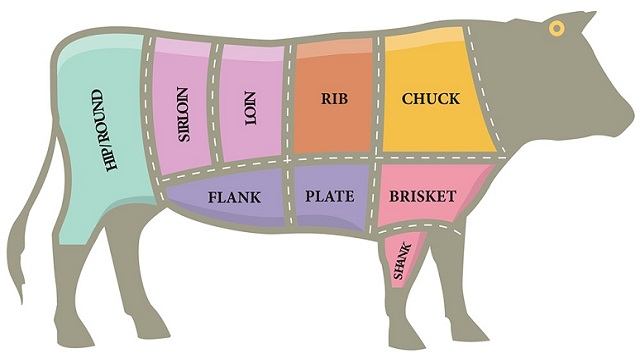
Main Primal Cuts of Beef
Chuck: What It’s Like and How to Cook It
The chuck primal cut around the cow’s shoulder is famous for its strong beef flavor. It has quite a bit of connective tissue which can make it tougher so it’s great for low and slow cooking methods. Here are some popular ways to cook chuck:
- Braising: Searing the meat at a high heat then cooking it slowly in liquid to help make it tender.
- Stewing: Cutting it into smaller bits and cooking in tasty liquids to boost the natural flavor.
Some favorite dishes that use chuck are pot roast and beef stew.
Rib: Cooking and Popular Cuts
The rib primal cut from the back of the cow is a favorite for beef lovers because of its great marbling and tenderness. Cuts like ribeye steaks and prime rib shine with just basic seasoning and are perfect for:
- Grilling: High heat really brings out the natural flavor.
- Roasting: Great for larger cuts to ensure even cooking.
The juicy ribeye is often the star of special meals showing off its flavor when cooked right.
Loin: Types of Cuts and Cooking Ideas
The loin primal is well-known for its super tender cuts of beef. Found behind the ribs it gives us premium cuts like:
- Filet Mignon: So soft and luxurious best grilled or pan-seared.
- New York Strip: Delivers great flavor often grilled or broiled.
Because it has low connective tissue quick cooking methods are best to keep it tender.
Round: Description and Cooking Tips
Round primal cuts come from the rear leg of the cow and they’re less fatty and tougher from all that muscle use. But they still pack a big beefy flavor making them good choices on a budget. Best cooking methods include:
- Braising: Great for tough cuts like the bottom round to help make them tender.
- Roasting: Especially for rump roasts sliced thin for sandwiches.
Trying out marinades can really improve the flavor and texture of round cuts making them versatile in any kitchen.
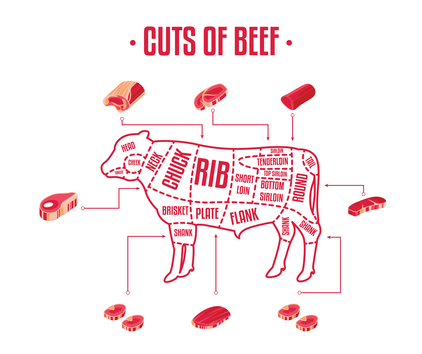
Lesser-Known Primal Cuts and Specialty Cuts
Flank: Uses in Various Dishes
Flank steak might not be as well-known but it’s become popular in many cuisines because of its bold beefy taste. Found below the loin it’s lean and shines when marinated and cooked at high heat. It’s often featured in:
- Fajitas: Flank steak is marinated and grilled sliced thin for soft tortillas with peppers and onions shoved in.
- Stir-Fries: Its texture means it soaks up flavors great making it ideal for quick cooking methods.
- London Broil: A dish where the flank is marinated and broiled giving a tasty flavor at a good price.
Brisket: Cooking Details and Techniques
Brisket is really important in the cooking world especially in barbecue scenes. It comes from the cow’s lower chest and is known for being tough but full of flavor. To get it tender it’s best to cook brisket using:
- Low and Slow Cooking: Perfect for smoking braising or sous vide letting those connective tissues break down.
- Seasoning: A good rub before cooking makes its natural flavors pop.
Whether it’s served as smoked brisket or used in classic dishes like corned beef it’s a must-have for any meat lover.
Shank and Plate: Unique Features and Dishes
Shank and plate cuts may not be the stars of the show but they bring unique flavors and textures. Shank cuts from the legs are perfect for:
- Osso Buco: An Italian dish with shank braised with veggies and broth making for a cozy meal.
- Soups and Stews: Their toughness breaks down wonderfully during long cooking making rich beefy broths.
The plate part is fatty and diverse yielding say:
- Skirt Steak: Ideal for grilling or as filling in tacos.
- Short Ribs: They really shine when braised or cooked slowly giving great tenderness and flavor.
These lesser-known cuts can take your meals to a whole new level adding depth and richness to your table.
Byproducts and Offal
Getting to Know Offal and What to Do with It
Offal includes all the internal organs and non-muscle parts of beef that often get overlooked in cooking. Even though many people shy away from offal it has a rich background in cooking and can give a unique flavor if prepared properly. Here’s why you should think about including offal in your meals:
- Nutritional Value: Offal is loaded with vitamins and minerals making it super nutritious.
- Flavorful Dishes: When cooked the right way offal can taste amazing. Think about liver pâté or beef tongue tacos which really show off the great taste of these cuts.
A lot of traditional cooking styles celebrate offal treating it as a delicacy instead of something to toss out.
Common Byproducts and How They’re Used
Along with offal beef byproducts come from different parts of the animal adding to a variety of cooking options:
- Tripe: The lining of the stomach used in soups and stews like menudo.
- Kidneys and Heart: Often found in pates or sautéed dishes adding rich flavors.
- Bones and Fat: Perfect for making stocks sauces or turning into tallow for cooking.
Using byproducts can inspire creative cooking while making full use of the animal reducing waste and upping your cooking game. Consider trying out these cuts in your next meal for a fun twist!
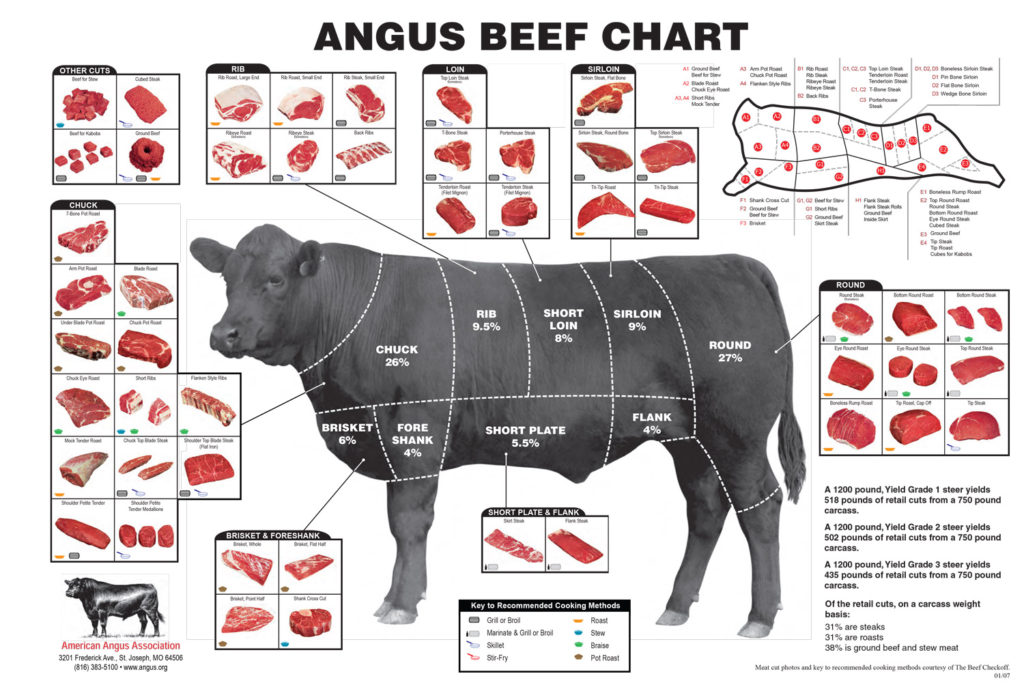
Picking the Right Cuts and Cooking Tips
Things to Keep in Mind When Choosing Beef
When you’re out shopping for beef knowing what to keep in mind can totally change your cooking experience. Here are some quick tips:
- Cooking Method: Different cuts are better for different cooking styles. Tender cuts from the loin are good for grilling while tougher cuts like brisket are great for slow cooking.
- Flavor: Think about whether you like deep beefy flavors or something lighter. Cuts with more fat like ribeye are usually more flavorful.
- Budget: Prices can vary a lot across different cuts. If you’re feeding a crowd look at cuts like chuck or round since they’re usually more wallet-friendly.
Tips for Getting the Most from Beef Cuts
Getting things ready is key for tasty results. Here are some easy tips for popular primal cuts:
- Marinating: Cuts like flank and skirt steaks really benefit from marinating for tenderness and flavor.
- Searing: For ribeye making sure to sear it helps keep in moisture and boosts flavor. Go for high heat on the grill.
- Low and Slow: Cuts like brisket and chuck do best when cooked at low temperatures. Take your time with braising or smoking to get that melt-in-your-mouth texture.
Keeping these tips in mind can make your beef dishes shine making every meal a tasty experience.
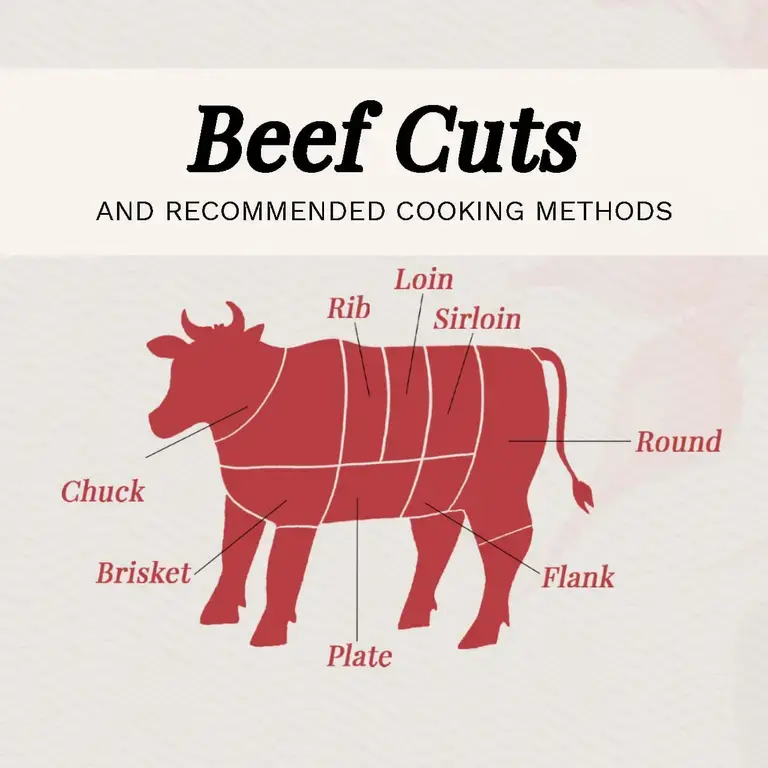
Local and Global Primal Cuts Variations
Primal Cut Differences by Region
When it comes to primal cuts the names and options can change a lot from one place to another. Here are some key differences:
- In the U.S. folks usually label cuts based on traditional steaks and roasts that people love. Cuts like prime rib and ribeye steaks are really popular.
- In France cuts might be named after how they’re cooked like “entrecôte” for rib cuts or “bœuf bourguignon” for a traditional stew that might use chuck or round cuts.
- Asian cuisines might focus on different cuts altogether often using tougher cuts like flank or shank for dishes like stir-fries or braised meals which might not be as favored in Western cooking.
Cultural Cooking Styles and Dishes
- In Mexican cooking flank and skirt steaks are often used in fajitas grilled beautifully and served with fresh veggies.
- In Italy osso buco made from the shank is adored for its rich flavor and traditionally served with gremolata.
- Places known for their barbecue like Texas turn brisket into a smoky treasure often cooked for hours to get it tender and flavorful.
These differences highlight how primal cuts can be celebrated in many ways making the cooking world beautifully varied.
Sustainable Beef Production
Why Sustainable Beef Matters
Being aware of sustainable beef production is becoming really important as it connects to keeping our environment healthy treating animals well and ensuring we have food for the future. With more people eating meat understanding sustainability in beef production is essential. Check out these key points:
- Resource Efficiency: Sustainable practices focus on using resources wisely cutting down waste and protecting the environment.
- Biodiversity: Well-managed grazing lands can help support a variety of ecosystems benefiting animal well-being and the environment.
- Climate Impact: Sustainable beef production aims to lower greenhouse gas emissions which is key in fighting climate change.
Eco-Friendly Choices and Ethics
Choosing sustainable beef shows you care about ethical farming. Here are some green things to think about:
- Grass-Fed Beef: Picking grass-fed options usually means healthier animals and better land use. Plus it often contains more omega-3 fatty acids.
- Buy Local: Supporting local farms reduces transportation emissions and boosts community economies.
- Animal Welfare: Making sure cattle are raised humanely leads to healthier animals and top-notch beef.
By making smart meat choices you can help promote sustainable practices in the beef industry.
Frequently Asked Questions About Beef Cuts
What is the most tender cut of beef?
The tenderloin (filet mignon), found in the loin primal, is the most tender cut of beef. It has minimal connective tissue and fat, resulting in its renowned tenderness. However, this tenderness comes at the expense of some flavor compared to fattier cuts.
Which beef cut is best for slow cooking?
Brisket, chuck, and shank are ideal for slow cooking methods. These cuts have more connective tissue that breaks down during long, low-temperature cooking, resulting in tender, flavorful meat. They’re perfect for braising, smoking, and stewing.
How do I choose the right beef cut for grilling?
For grilling, choose cuts from the rib and loin primals like ribeye, strip steak, or tenderloin. These cuts have good marbling and tenderness that respond well to quick, high-heat cooking methods. For more budget-friendly options, flank steak and skirt steak are excellent when marinated and cooked quickly.
What’s the difference between grass-fed and grain-fed beef?
Grass-fed beef comes from cattle that graze on pasture their entire lives, resulting in leaner meat with higher omega-3 fatty acids and a distinct flavor profile. Grain-fed beef comes from cattle finished on grain diets, producing more marbling, a milder flavor, and often more tender meat. The choice between them depends on taste preference, nutritional priorities, and ethical considerations.
How should I store different cuts of beef?
Fresh beef cuts should be stored in the refrigerator at 40°F or below and used within 3-5 days. For longer storage, wrap cuts tightly in freezer paper or vacuum seal them before freezing, where they’ll keep for 6-12 months depending on the cut. Thicker cuts with more fat content, like ribeye, maintain quality longer in the freezer than leaner cuts like tenderloin.
Wrapping It Up
Key Takeaways
As we’ve explored beef cuts we’ve talked about primal cuts their origins and what makes each unique. Here’s a recap of the important points:
- Eight Primal Cuts: These are chuck rib loin round flank short plate brisket and shank each offering different flavor and texture.
- Cooking Techniques: Cuts need different cooking methods. Like brisket benefits from low and slow cooking while loin cuts are better suited for high-heat cooking.
- Sustainability: Choosing grass-fed or locally sourced beef supports ethical practices and may give better nutritional benefits.
Final Thoughts on Beef Cuts
Getting a grip on beef primal cuts helps you make better choices. Whether you’re grilling tenderloin for a special occasion or whipping up a comforting chuck stew knowing the right cut and how to cook it expands your culinary skills.
Exploring these cuts lets you admire the versatility of beef and shows us there’s a whole world of flavors ready for experimentation in the kitchen. So whether you’re new to cooking or a seasoned pro go ahead and embrace these cuts with confidence and creativity!
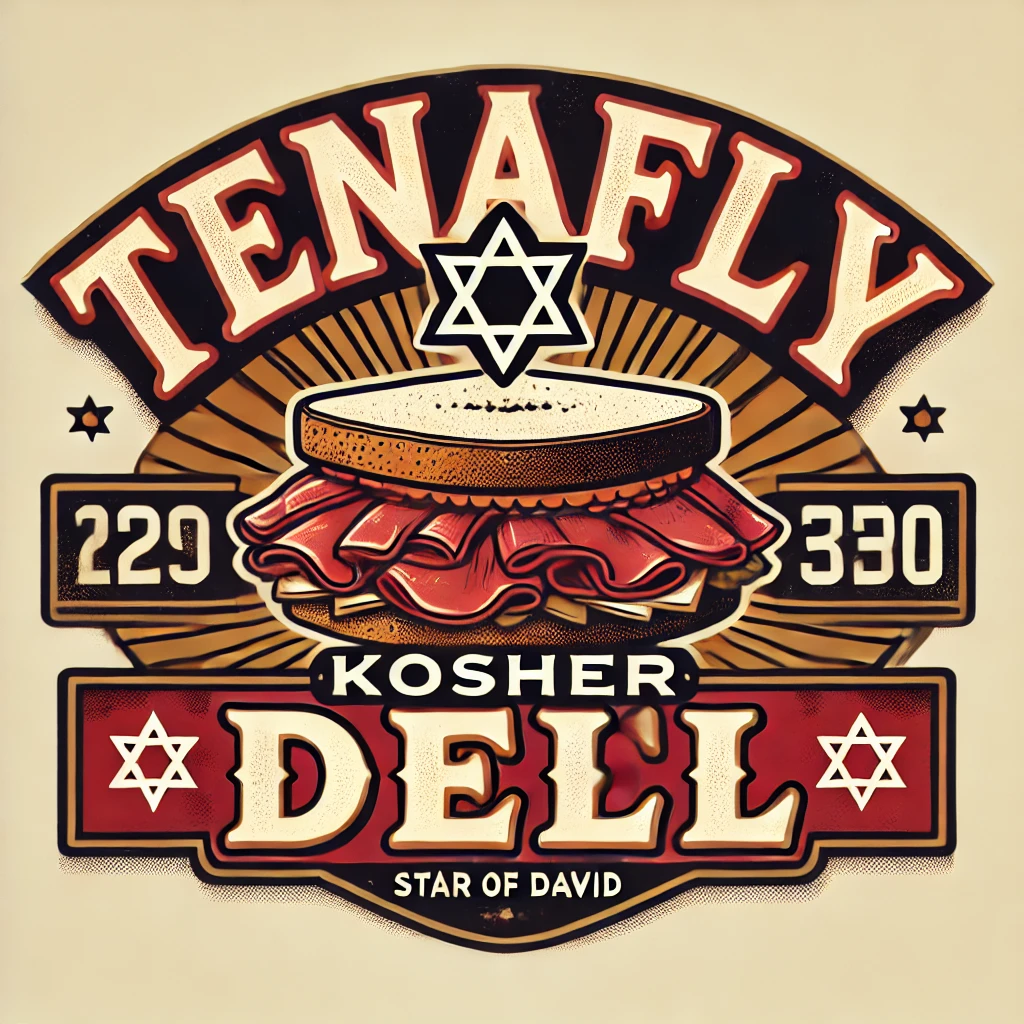
A Bergen County institution celebrating authentic Jewish cuisine since 1985. Our pastrami—brined for 14 days, smoked over applewood for 12 hours, and steamed to perfection—creates a melt-in-your-mouth experience that rivals Manhattan’s finest delis. Our rye bread is baked fresh daily using a century-old recipe from Poland. Featured in Food & Wine’s “Top 10 Delicatessens in America” and on Food Network’s “Best Thing I Ever Ate.” Chef Moshe Greenbaum, a third-generation deli master trained at the Culinary Institute of America, ensures every sandwich meets our exacting standards. No wonder our customers drive from three states away.
Leave a Reply